
Candlemas. The tradition in France.
Hello,
Just a note worth reading to explain why the photos are not visible.
As you will see, we have not been able to upload the photos....we even tried with free photos from Pixabay and Shutterstock but without success. So we eventually decided to add the link to the document on the drive and you will be able to see the photos. You will also read on this document the first draft as some modification and corrections have been done directly on the Twinspace page. Due to our departure for Spain on Monday, we don't have the time to edit again the pages on the Drive. Sorry for the first blank page on some links too, but it is added for no reason by the system and we have not been able to change it.
As we will visit two restaurants in Zaragossa, Spain, we will take photos and share them with you in March.
David
The Brittany crepe is a traditional dish commonly eaten in Britanny. Now particularly reknown in France and elsewhere, it is also served in “creperies”, plain or garnished with various ingredients, salted or sweetened according to the recipe
Traditionally, the dough is in principle baked on a specific device called “bilig” in Breton, which is the traditional language of Brittany (Northwest region of France). The dough is spread into discs using a kind of small rake called among others rozell, rouable or raclette.
The preparation of pancakes on the basis of the Brittany recipe is also done with a simple crepe maker, or even a frying pan.
Brittany pancakes (krampouezh in Breton) are a very famous Breton culinary specialty, and Brittany has many “creperies” or “crepes restaurants”.
There are two types of pancakes:
- with wheat or blue flour gwinizh. The traditional dough consists of eggs, flour, sugar and milk. It is mainly consumed in a sweet form;
- with buckwheat flour (or buckwheat) or blue-eyed wheat flour. The traditional dough is made exclusively of buckwheat flour, water and salt. This is the savoury version of the crepes which can have different fillings like ham and egg or smoked salmon and sour cream.
Sweet or savoury (salty), pancakes are traditionally eaten hot with butter. The most common filling for so-called "salty" pancakes is grated cheese, ham, an egg and is said to be "complete" when all three ingredients are present simultaneously. For so-called "sweet" pancakes, the commonly used ingredients are: butter, sugar, chocolate, Nutella, jam etc.
Dessert crepes recipe.
Preparation: 10 min Cooking: 25 min Pancakes: 12
250 g wheat flour
70 g brown sugar
2 eggs
1 tablespoon of oil
1 pinch of salt
1/2 l milk
Rum and a little vanilla sugar
Main dish crepes recipe.
500 g buckwheat flour/buckwheat buckwheat
2 tablespoons wheat flour (or fluid wheat flour)
2 medium eggs
1 teaspoon of salt
1 liter of cold water (spring water would be better)
25 cl of “ribot” milk (or the equivalent of beer or cider)
3 tablespoons of oil or melted butter.
For cooking: butter
Creperies are typical of Brittany but there are all over France and are often called “Creperie Bretonne” which means “Crepes restaurant from Brittany”
Brittany is the region in red on the map.
We are in the southwest. Our department is number 32 (Gers)
By Pauline, Henry and Zacharie.
https://drive.google.com/open?id=1Uyhi9F6XVgUXC2K2S_5G0pjgvnrOAcXP
THE HISTORY OF CANDLEMAS which is called LA CHANDELEUR in French.
In Roman times, it was a celebration in honour of the god Pan. All night long, believers walked the streets of Rome waving torches. In 1472, the Pope made it a religious holiday, which would become the celebration of Jesus' presentation at the temple. Candlelight processions are then organized on Candlemas Day, according to a specific technique: each believer must collect a candle in the church and bring it home, taking care to keep it lit!
This blessed candle is supposed to have other powers. It is said that a few drops of its wax poured on hatching eggs ensure a good hatching. And also that its flame protects from lightning if it is lit during a storm.
TRADITIONS
The tradition at Candlemas is to hold a gold coin in the left hand, while the first pancake is thrown into the air to turn it. If the pancake falls back into the pan properly, there will be no shortage of money during the year. Well, that’s what people believe, but I don’t !!!
By Noa and Stevens
https://drive.google.com/open?id=16fm-8asgSxSKIFQUaAtrMfaQknrNLPMp
Candlemas in France
Candlemas (Chandeleur in French) is an ancient pagan and Latin festival, which later became a Christian religious festival corresponding to the Presentation of Christ in the Temple and his recognition by Simeon as "Light of Israel". This celebration takes place on February 2, 40 days after Christmas.
For this celebration we eat a lot of pancakes with sugar, maple syrup, jam… It’s a good way to use all the eggs we have before Lent! Indeed, we are not supposed to eat meat or eggs during
Lent
In French restaurant, we eat crêpes Suzette.
For example, at school we flame the crêpes suzette in front of the customers.
By Noélie and Enzo
https://drive.google.com/open?id=1NvdUjJQHfE2reMSZoBOusmujeF3WZ1zK
Traditional sweet crepes dough
sun ymane
Ingredients :
500g flour
1Little packet of vanilla sugar
50cl of milk
50cl water
40g butter
1pinch of salt
Rum, Cognac, Calvados or Grand marnier
STEP 1
Take the butter out of the refrigerator, cut it into small pieces and let it become an ointment at room temperature. This will make it easier to incorporate. If you are short of time, put in the microwave in a suitable container for a few minutes.
STEP 2
Sift the flour and vanilla sugar into a bowl.
STEP 3
Using a hand whisk, beat the eggs into an omelette in a bowl and add a pinch of salt and gently add them to the flour. Dissolve it all with milk and water. To prevent lumps from forming, pour them in as you go, while continuing to stir vigorously.
STEP 4
Flavour the dough with a small glass of rum, or cognac, or calvados or Grand Marnier. The alcohol evaporates during cooking and only a sweet scent remains in each pancake.
STEP 5
Finally add the melted butter and mix with the whisk until the pancake batter is smooth and creamy, but not too liquid. If this is the case, add a little flour to the mixture again. Let it rest for 2 hours at room temperature, covering it with a dry cloth. If lumps have formed on the surface during the rest period, do not hesitate to reuse your whisk to break them before starting cooking.
Baking
Step1.
Lightly butter the well heated pancake pan (special pan, smaller in diameter than the regular pan and made of very thick sheet metal) with a brush or piece of cloth dipped in butter.
Step2.
Pour into the pan the amount necessary to ensure that the bottom of the utensil is well covered, and taking into account that the pancake must be made excessively thin; cook over high heat.
step 3. As soon as the pancake starts to swell in places, turn it over by jumping it.
By Jade and Ymane
https://drive.google.com/open?id=1AZ9qtNo4PULchm5geKEOftsponj1KZ_1
Discuss
You can add comment and share if you have a similar tradition in your country.
Carnival in Poland. Fat Thursday.
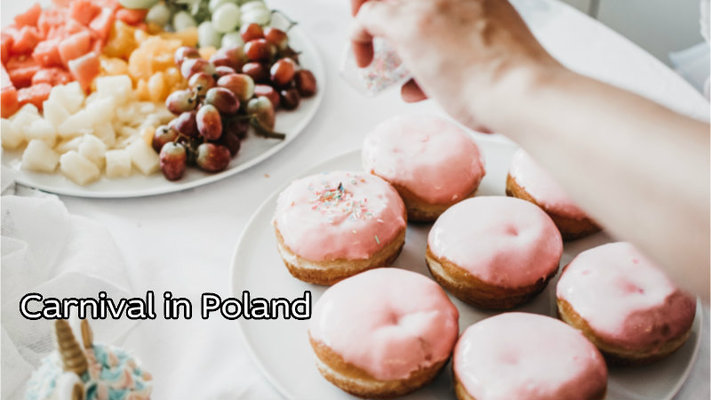
Carnival period begins with the "Holiday of the Three Kings". The 6th of January is a work free day. On this day in cities and towns there are religious parades. People dress up in costumes of kings and residents of ancient Palestine. You can see kids wearing robes or decorative capes. Sometimes there are even animals - in Warsaw, for example, there were lamas!
In the past fancy dress parties used to be very popular, especially among gentry. Tables would yield under loads of meats and bakery goods. People used to have fun during sleigh rides. Nowadays winters are not so severe and the amount of snow does not always allow this. The parties are also not as frequent - they are limited mostly to the last weekend before Ash Wednesday.
The most commonly followed tradition in Poland is baking, and of course eating, lots of doughnuts, faworki ( or Polish chruściki) and carnival roses. They are supposed to bring good fortune and everybody is supposed to eat at least one. Therefore there are long queues in front of well-known confectioneries. People are willing to wait even an hour in line to get the best doughnuts with rose jam / toffi / chocolate filling.
The last Tuesday of Carnival season is the moment when you can really indulge yourself for the last time before lent. This evening has different names in various regions of Poland. We call it "śledzik" (herring), as we eat this fish prepared in numerous ways. Most common are salted or marinated herrings with olive and onion or served with tomato sauce. These appetisers go well with alcoholic beverages, which (traditionally) are not supposed to appear on our tables during lent.
Carnival Roses recipe.
- 2,5 cups of wheat flour (450g)
- 5 egg yolks
- 1 tablespoon of spirits (or rum)
- ½ teaspoon of sugar
- ½ teaspoon of salt
- ¾ glass of thick sour cream (18%)
- Oil or lard for frying
- Powdered sugar for decoration
- Any jam or cherries
Mix flour, egg yolks, sour cream, sugar, rum, and salt in a large bowl; mix to form a dough.
Knead dough lightly and roll out on a floured surface. Cut out 3 circles of different sizes (you can use glasses of different sizes). Make 3 little cuts on the edge of each circle
Put 3 dough circles together with the smallest circle on top – press gently in the middle for them to stick together. You can use a bit of egg white as „glue”
Heat oil in a deep-fryer or large saucepan. Test the temperature by dropping in a pastry twist; the oil is ready when it browns and float to the surface.
Fry your roses until golden brown, about 1 minute per side.
Drain on a plate lined with paper towels.
Dust with powdered sugar.
Place a cherry or a lump of cherry jam in the middle of the smallest circles
The Carnival dishes prepared and photographed by Marzena Hybel, Natalia Leja, Dominika Gancarczyk, Iwona Bednarek and Weronika Ubik- the students od Zespół Szkół Nr 1, Limanowa.
stuffed chicken breasts, roast duck, doughnuts.
Recipe for stuffed chicken breasts
500 g skinless chicken breasts
1 cup of dried cranberries
½ medium sized smoked ewe’s milk cheese
2 branches of chopped rosemary
3 teaspoons of dried paprika
1.5 teaspoon of pepper
2 teaspoons of dried garlic
3 teaspoons of salt
¾ glasses of white wine
frying oil
a handful of chopped fresh parsley
½ cup of breadcrumbs
2-3 teaspoons of fresh basil
toothpicks
Preparation:
1. Clean the chicken breast and make lengthwise cut in thick side of each chicken breast, being careful to not cut through to opposite side. Pound each breast with a meat mallet. Rub the meat with garlic, salt, pepper and paprika.
2. Cut the cheese into strips. Pour hot water over cranberries and leave for a few minutes. Then, drain the cranberries. Put a piece of cheese and some cranberries on each piece of meat. Fold in half to enclose filling. Secure with wooden toothpicks.
3. Fry the rolls in hot oil on each side. Transfer them to a heat resistant container. Pour over with wine, the fat from frying and add the chopped rosemary. Bake for about 20 minutes at 180degrees Celsius. At the end of baking add the remaining cranberries.
4. Blend the parsley and combine it with breadcrumbs. Dredge the rolls with parsley and breadcumbs mixture.
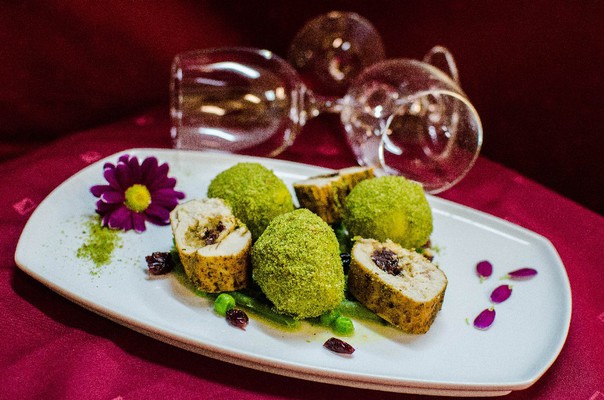
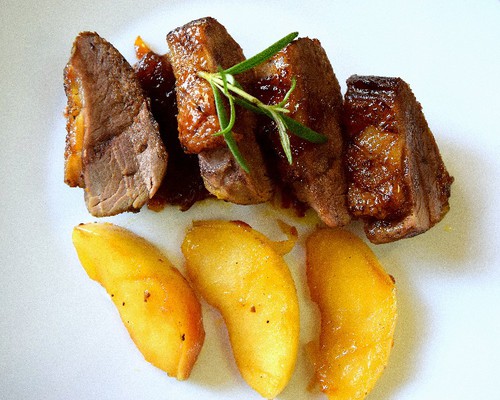
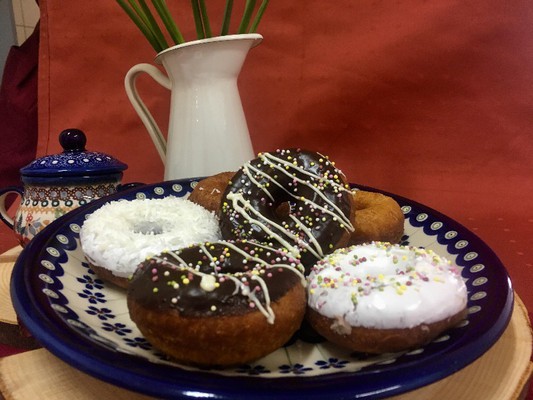
Greek carnival season-Apokries
The Carnival season, or “Apokries” in Greek, means "no meat", as the Greek word for "meat" is "kreas"(apo-kreas). Nowadays, the period of apokries is associated with the Orthodox traditions of a three week preparation period before the 40 day lenten fast which precedes Easter, many traditions around Greece have their roots in ancient times. is divided in 3 weeks, all preparing for the fasting period. The first week opens the carnival and starts with a specific church celebration. The second week is called ‘Kreatini’ in which one is allowed to eat meat every day. The Thursday in that week is called ‘Tsiknopemptee’. ‘Tsikno’ means the smell of grilled meat and ‘Pempti’ means Thursday. This Thursday is a day to take your family out to a tavern and eat grilled meat. Tsiknopemptee is also the day when the parties start and the first masquerades make their appearance. The last week before Lent is called the Cheese Week, White Week or ‘Tyrini’. Only dairy and fish is allowed, no meat. The carnival ends on ‘Kathara Deftera’ or Clean Monday.
In Ancient Greece there were celebrations at this time of year to commemorate the end of winter and the coming of spring which were associated with the worship of Dionysos, the God of Wine and Feast.The ancient Greeks celebrated this flower – and wine festival on the 12th day of the Spring, the ‘Anthesterion’ around February – March. On the first day of the party one opened the first wine barrels with the new wine. There were prayers and wine worship. Everyone had a day-off, even the slaves. The second day of the celebrations marked a big food and wine party that lasted until the early morning hours. The highlight of this day was a parade with a Dionysos, a fancy dress up entering the city. The dressing up, the masks and wine let their wearers lose their worries and their (respectable) selves and have fun.
The most known Carnival celebrations in Greece are: Patra's, Xanthi's, Tyrnavou and Rethymnou.
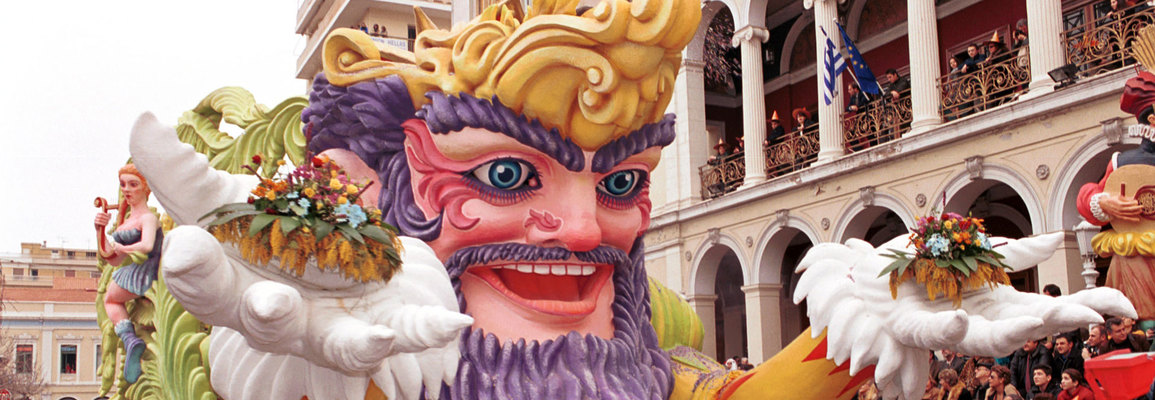
The Patras Carnival is the largest event of its kind in Greece and one of the biggest in Europe. Giant decorated cars, carts and coaches, and colourful papier-mâché figures fill the city streets for a full weekend of street parades and parties. A key character is the Carnival King, presented in all his splendour. The carnival also has its Queen, who is actually a beautiful young lady on a floral or an artistic float. Thousands of carnival participants are organized into groups and dance holding torches in the dimly lit streets of the city.
These information are the result of a team work by Chrysa-Poly-Georgia and Lambrini.
We have also prepared for you a video in order to celebrate Tsiknopempti with us at our school. Enjoy it!!
In this point we'd like to share with you a WebQuest we've created within the co-funded Erasmus plus KA2 partnership “English for hospitality” (EN4HOSTS), project number: 2017-1-RO01-KA201-037159, KA2 - Cooperation for Innovation and the Exchange of Good Practices, KA201 - Strategic Partnerships for school education. It's theme is "Apokries in Greece : Customs &Food" and it would be our pleasure to use it in your classes in order to discover how we celebrate Apokries (Greek Carnival). GREEK APOKRIES
Don't think that we haven't read your carnival traditions (Franve and Poland). We did it and we tried to make crepes and doughnuts. This day we had two little girls in class who acted as our tasters and parallel helped with the record of our presentation.
For the dounuts recipe worked: Chrysa, Poly, Lambrini and Vasilis.The recorded video made by Antonis with the help of little Elina and Alexandra.
For the crepes recipe worked: Anta, Georgia, Konstantina, Konstantinos, Bill and Katerina.
